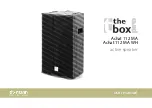
06
more EVERYWHERE speakers. The benefit of Wi-Fi over Bluetooth is important – Wi-Fi allows you to stream one
source to EVERYWHERE speakers all over your house (because Wi-Fi typically has longer range), and the
bandwidth of Wi-Fi is much higher than Bluetooth, so the quality of the sound performance is essentially the same
as a 3.5mm wired audio connection.
Of course, Wi-Fi performance in the home is influenced by many factors – the quality of your wireless router, how
many people are connected to the router and downloading at the same time, the number of routers that are
active (which is really important in high-density housing such as apartment buildings).
In general, we recommend a maximum of three EVERYWHERE speakers connected to your router. More is
possible if you take certain technical steps to improve your bandwidth – but that discussion is beyond the scope
of this manual.
And Wi-Fi performance is impacted by the capability of your Wi-Fi enable digital device – for example, an iOS
based product such as an iPhone can only reliably connect to one Wi-Fi device at a time. But if you use iTunes on
your PC or Mac, you can connect to multiple EVERYWHERE speakers. You can also use Android smartphones,
tablets and PC’s to connect using a standard known as DLNA, and connects to multiple EVERYWHERE
speakers.
Wired Ethernet:
Wired Ethernet, where the EVERYWHERE is connected to your router or Ethernet switch with an Ethernet cable
will give you the best performance. You can typically connect many more than three EVERYWHERE speakers.
Ultimately, there is a limitation of your router or Ethernet switch, but for most standard residential users this is not
a factor. And wired Ethernet will give you the audio performance of a 3.5mm wired connection.
So the first decision you will have to make is how you want to connect to EVERYWHERE. Once you make that
decision, then you can follow the easy steps in this manual to start enjoying your music.
If you are using an iPhone or /and Android device, we have an app that makes it easy to set-up your
EVERYWHERE. You can use the app to connect the EVERYWHERE to your home network, you can name it
(Living Room, Kitchen, Den), and you can assign EVERYWHERE speakers to groups, so that you can play your
music to one, some or all EVERYWHERE speakers.
The EVERYWHERE application also updates the software on your EVERYWHERE speaker, keeping it current and
up to date. The EVERYWHERE application does not take the place of your music player software, such as iTunes,
Windows Media Player or streaming music service applications such as Pandora. The application lets you
configure your EVERYWHERE speakers, and then you use your favorite applications to select and play music.
Product Introduction









































